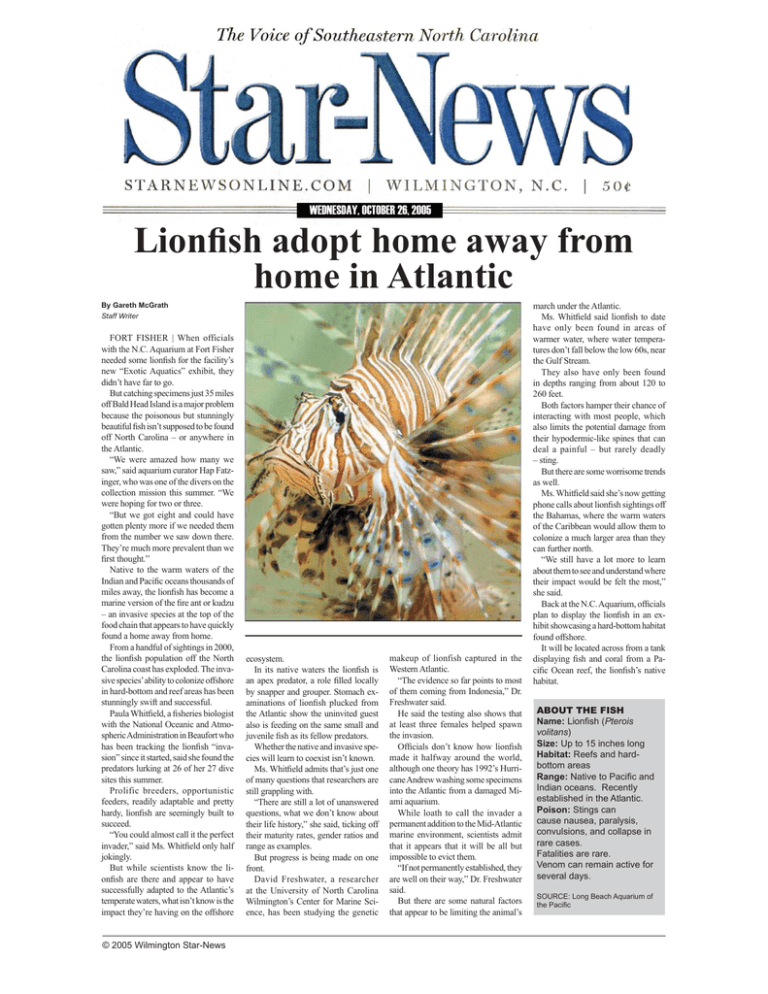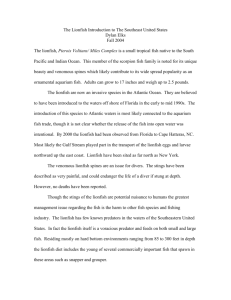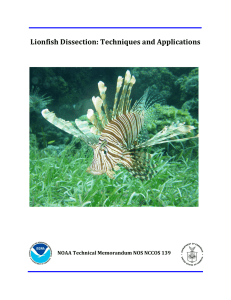FORT FISHER | When officials
advertisement

WEDNESDAY, OCTOBER 26, 2005 Lionfish adopt home away from home in Atlantic By Gareth McGrath Staff Writer FORT FISHER | When officials with the N.C. Aquarium at Fort Fisher needed some lionfish for the facility’s new “Exotic Aquatics” exhibit, they didn’t have far to go. But catching specimens just 35 miles off Bald Head Island is a major problem because the poisonous but stunningly beautiful fish isn’t supposed to be found off North Carolina – or anywhere in the Atlantic. “We were amazed how many we saw,” said aquarium curator Hap Fatzinger, who was one of the divers on the collection mission this summer. “We were hoping for two or three. “But we got eight and could have gotten plenty more if we needed them from the number we saw down there. They’re much more prevalent than we first thought.” Native to the warm waters of the Indian and Pacific oceans thousands of miles away, the lionfish has become a marine version of the fire ant or kudzu – an invasive species at the top of the food chain that appears to have quickly found a home away from home. From a handful of sightings in 2000, the lionfish population off the North Carolina coast has exploded. The invasive species’ ability to colonize offshore in hard-bottom and reef areas has been stunningly swift and successful. Paula Whitfield, a fisheries biologist with the National Oceanic and Atmospheric Administration in Beaufort who has been tracking the lionfish “invasion” since it started, said she found the predators lurking at 26 of her 27 dive sites this summer. Prolific breeders, opportunistic feeders, readily adaptable and pretty hardy, lionfish are seemingly built to succeed. “You could almost call it the perfect invader,” said Ms. Whitfield only half jokingly. But while scientists know the lionfish are there and appear to have successfully adapted to the Atlantic’s temperate waters, what isn’t know is the impact they’re having on the offshore © 2005 Wilmington Star-News ecosystem. In its native waters the lionfish is an apex predator, a role filled locally by snapper and grouper. Stomach examinations of lionfish plucked from the Atlantic show the uninvited guest also is feeding on the same small and juvenile fish as its fellow predators. Whether the native and invasive species will learn to coexist isn’t known. Ms. Whitfield admits that’s just one of many questions that researchers are still grappling with. “There are still a lot of unanswered questions, what we don’t know about their life history,” she said, ticking off their maturity rates, gender ratios and range as examples. But progress is being made on one front. David Freshwater, a researcher at the University of North Carolina Wilmington’s Center for Marine Science, has been studying the genetic makeup of lionfish captured in the Western Atlantic. “The evidence so far points to most of them coming from Indonesia,” Dr. Freshwater said. He said the testing also shows that at least three females helped spawn the invasion. Officials don’t know how lionfish made it halfway around the world, although one theory has 1992’s Hurricane Andrew washing some specimens into the Atlantic from a damaged Miami aquarium. While loath to call the invader a permanent addition to the Mid-Atlantic marine environment, scientists admit that it appears that it will be all but impossible to evict them. “If not permanently established, they are well on their way,” Dr. Freshwater said. But there are some natural factors that appear to be limiting the animal’s march under the Atlantic. Ms. Whitfield said lionfish to date have only been found in areas of warmer water, where water temperatures don’t fall below the low 60s, near the Gulf Stream. They also have only been found in depths ranging from about 120 to 260 feet. Both factors hamper their chance of interacting with most people, which also limits the potential damage from their hypodermic-like spines that can deal a painful – but rarely deadly – sting. But there are some worrisome trends as well. Ms. Whitfield said she’s now getting phone calls about lionfish sightings off the Bahamas, where the warm waters of the Caribbean would allow them to colonize a much larger area than they can further north. “We still have a lot more to learn about them to see and understand where their impact would be felt the most,” she said. Back at the N.C. Aquarium, officials plan to display the lionfish in an exhibit showcasing a hard-bottom habitat found offshore. It will be located across from a tank displaying fish and coral from a Pacific Ocean reef, the lionfish’s native habitat. ABOUT THE FISH Name: Lionfish (Pterois volitans) Size: Up to 15 inches long Habitat: Reefs and hardbottom areas Range: Native to Pacific and Indian oceans. Recently established in the Atlantic. Poison: Stings can cause nausea, paralysis, convulsions, and collapse in rare cases. Fatalities are rare. Venom can remain active for several days. SOURCE: Long Beach Aquarium of the Pacific






